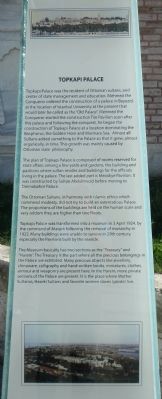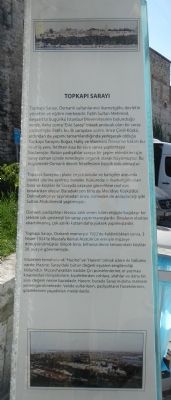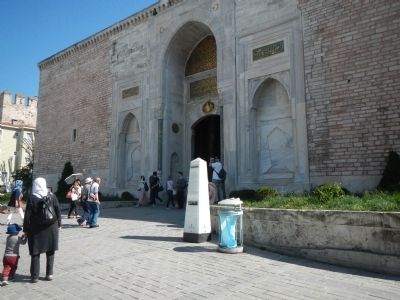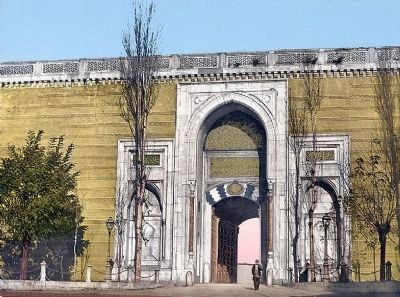Cankurtaran in İstanbul in Fatih, Turkey — West Asia or Southeast Europe
Topkapi Palace
Topkapı Sarayı
Topkapi Palace was the resident of Ottoman sultans, and center of state management and education. Mehmed the Conqueror ordered the construction of a palace in Bayezid, at the location of Istanbul University at the present that would later be called as the ”Old Palace". Mehmed the Conqueror started the construction Tile Pavilion soon after this palace and following the conquest, he began the construction of Topkapi Palace at a location dominating the Bosphorus, the Golden Horn and Marmara Sea. Almost all Sultans added something to the Palace so that it grew, almost organically, in time. This growth was mainly caused by Ottoman state philosophy.
The plan of Topkapi Palace is composed of rooms reserved for state affairs among a few yards and gardens, the building and pavilions where sultan resides and buildings for the officials living in the palace. The last added part is Mecidiye Pavilion. It was constructed by Sultan Abdulmecid before moving to Dolmabahce Palace.
The Ottoman Sultans, in harmony with Islamic ethics which commend modesty, did not try to build an ostentatious Palace. The proportions of the buildings are held on the human scale and very seldom they are higher than two floors.
Topkapi Palace was transformed into a museum in 3 April 1924, by the command of Ataturk following the removal of monarchy in 1922. Many buildings were unable to survive in 20th century, especially the Pavilions built by the seaside.
The Museum basically has two sections as the "Treasury" and "Harem”. The Treasury is the part where all the precious belongings in the Palace are exhibited. Many precious objects like jewellery (sic), chinaware, calligraphy and hand-written books, miniatures, clothes, armour and weaponry are present here. In the Harem, more private sections of the Palace are present. It is the place where Mother Sultanas, Haseki Sultans and favorite women slaves (gözde) live.
Turkish:
Topkapı Sarayı, Osmanlı sultanlarının ikametgâhı, devletin yönetim ve eğitim merkezidir. Fatih Sultan Mehmed, Beyazıt'ta bugünkü İstanbul Üniversitesinin bulunduğu yerde, daha sonra "Eski Saray" olarak anılacak olan bir saray yaptırmıştır. Fatih, bu ilk saraydan sonra, önce Çinili Köşkü, ardından da yapımı tamamlandığında yerleşecek olduğu Topkapı Sarayını Boğaz, Haliç ve Marmara Denizi'ne hâkim bu müthiş yere, fetihten kısa bir süre sonra yaptırmaya başlamıştır. Bütün padişahlar saraya bir şeyler ekledikleri için saray zaman içinde neredeyse organik olarak büyümüştür. Bu büyümede Osmanlı devlet felsefesinin büyük rolü olmuştur.
Topkapı Sarayının planı; çeşitli avlular ve bahçeler arasında devlet işlerine ayrılmış daireler, hükümdarın ikametgâhı olan bina ve köşkler ile Sarayda yaşayan görevlilere mahsus binalardan oluşur. Buradaki son bina da Mecidiye Köşkü'dür. DoImabahçe'ye taşınmadan önce, isminden de anlaşılacağı gibi Sultan Abdülmecid yaptırmıştır.
Osmanlı padişahları tevazu salık veren İslâm etiğiyle bağdaşır bir şekilde çok gösterişli bir saray yaptırmamışlardır. Binaların ebatları abartılmamış, çok azı iki kattan daha yüksek yapılmışlardır.
Topkapı Sarayı, Osmanlı monarşisi 1922'de kaldırıldıktan sonra, 3 Nisan 1924'te Mustafa Kemal Atatürk'ün emriyle müzeye dönüştürülmüştür. Birçok bina, bilhassa deniz kenarındaki köşkler 20. yüzyılı görememiştir.
Müze'nin temel olark "Hazine" ve "Harem" olmak üzere iki bölümü vardır. Hazine; Saraydaki bütün değerli eşyanın sergilendiği bölümdür. Mücevherattan nadide Çin porselenlerine, el yazması kitaplardan minyatürlere, kıyafetlerden zırhlara, silahlar ve daha bir sürü değerli nesne buradadır. Harem; burada Saray'ın daha mahrem yerleri görülmektedir. Valide sultanların, padişahların hasekilerinin, gözdelerinin yaşadıkları mekânlardır. Müzehin temel olarak"Hazine"ve"Harem"olmak üzere iki bölümü.
Erected by Istanbul Büyükşehir Belediyesi (Istanbul Metropolitan Municipality).
Topics. This historical marker is listed in this topic list: Forts and Castles. A significant historical date for this entry is April 3, 1924.
Location. 41° 0.507′ N, 28° 58.883′ E. Marker is in İstanbul, in Fatih. It is in Cankurtaran. Marker is at the intersection of Soğuk Ãeşme Sokak and Kabasakal Cadde, on the right when traveling east on Soğuk Ãeşme Sokak. Touch for map. Marker is at or near this postal address: Soğuk Ãeşme Sk ,, İstanbul 34122, Turkey. Touch for directions.
Other nearby markers. At least 8 other markers are within walking distance of this marker. The Fountain of Ahmed III (within shouting distance of this marker); The Türbe (Tomb) of Sultan Mehmed III (about 150 meters away, measured in a direct line); The Türbe (Tomb) of Sultan Selim II (about 150 meters away); The Remnants of the Theodosian Hagia Sophia (5th Century) (about 150 meters
away); Hagia Sophia (about 180 meters away); Haseki Hurrem Bathhouse (about 210 meters away); Million (approx. 0.3 kilometers away); The Milion Stone (approx. 0.3 kilometers away). Touch for a list and map of all markers in İstanbul.
More about this marker. The marker is to the right of the entrance to Topkapi Palace.
Also see . . . Topkapi Palace - Wikipedia. The palace complex consists of four main courtyards and many smaller buildings. At its peak, the palace was home to as many as 4,000 people, and covered a large area with a long shoreline. It contained mosques, a hospital, bakeries, and a mint. Construction began in 1459, ordered by Sultan Mehmed II, the conqueror of Byzantine Constantinople. It was originally called the New Palace (Yeni Saray) to distinguish it from the previous residence. It received the name "Topkapı" (Cannon Gate) in the 19th century, after a (now lost) gate and shore pavilion. (Submitted on June 22, 2015, by Barry Swackhamer of Brentwood, California.)
Credits. This page was last revised on February 13, 2023. It was originally submitted on June 22, 2015, by Barry Swackhamer of Brentwood, California. This page has been viewed 401 times since then and 12 times this year. Photos: 1, 2, 3. submitted on June 22, 2015, by Barry Swackhamer of Brentwood, California. 4. submitted on July 10, 2015. • Andrew Ruppenstein was the editor who published this page.



